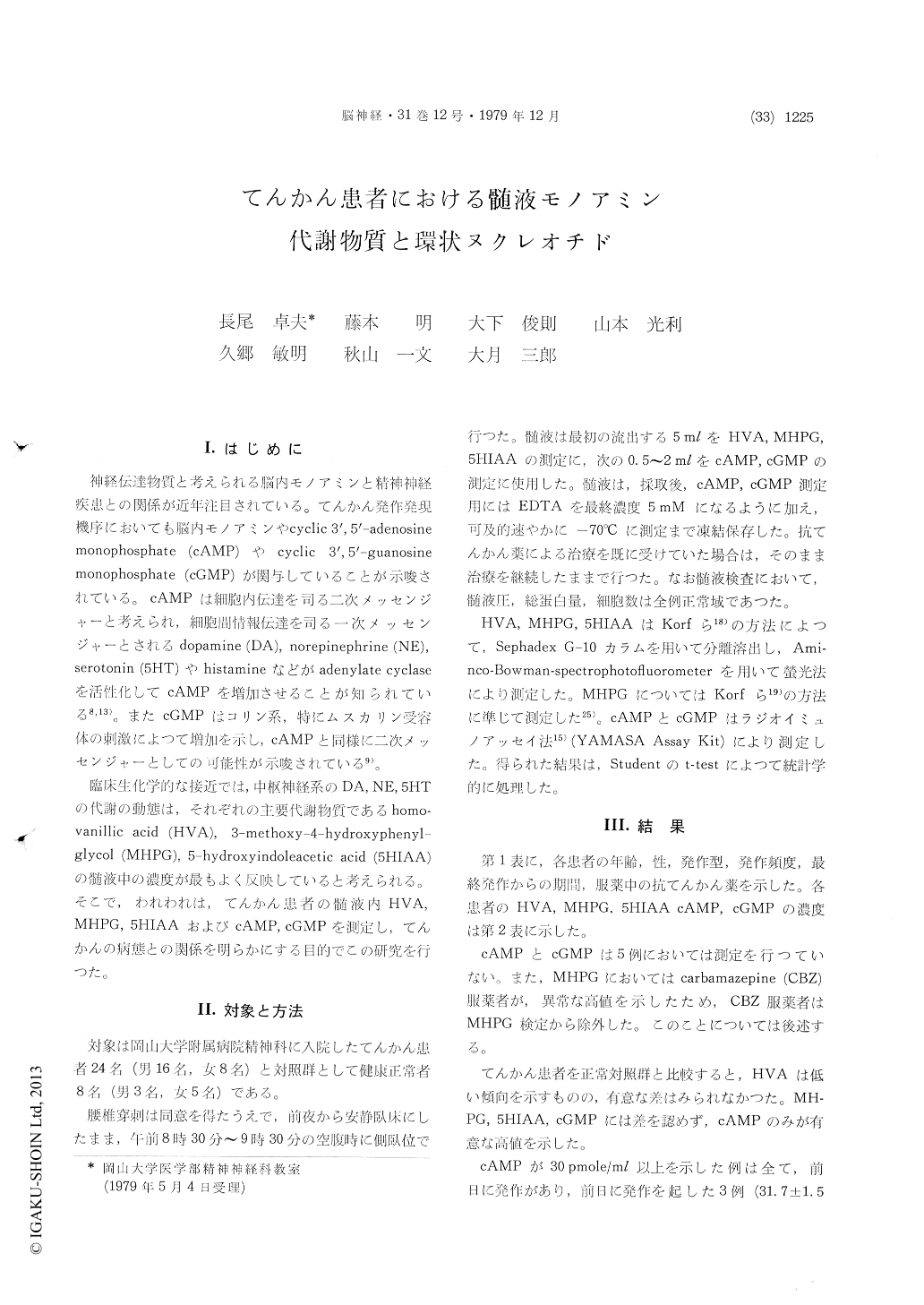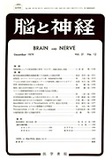Japanese
English
- 有料閲覧
- Abstract 文献概要
- 1ページ目 Look Inside
Ⅰ.はじめに
神経伝達物質と考えられる脳内モノアミンと精神神経疾患との関係が近年注目されている。てんかん発作発現機序においても脳内モノアミンやcyclic 3´,5´—adenosine monophosphate (cAMP)やcyclic 3´,5´—guanosine monophosphate (cGMP)が関与していることが示唆されている。cAMPは細胞内伝達を司る二次メッセンジャーと考えられ,細胞間情報伝達を司る一次メッセンジャーとされるdopamine (DA),norepinephrine (NE),serotonin (5HT)やhistamineなどがadenylate cyclaseを活性化してcAMPを増加させることが知られている8,13)。またcGMPはコリン系,特にムスカリン受容体の刺激によつて増加を示し,cAMPと同様に二次メッセンジャーとしての可能性が示唆されている9)。
臨床生化学的な接近では,中枢神経系のDA,NE,5HTの代謝の動態は,それぞれの主要代謝物質であるhomo—vanillic acid (HVA),3—methoxy−4—hydroxyphenyl—glycol (MHPG),5—hydroxyindoleacetic acid (5HIAA)の髄液中の濃度が最もよく反映していると考えられる。そこで,われわれは,てんかん患者の髄液内HVA,MHPG,5HIAAおよびcAMP,cGMPを測定し,てんかんの病態との関係を明らかにする目的でこの研究を行つた。
It has been postulated that brain monoamines and cyclic nucleotides may play important roles for epileptic seizures.
The levels of homovanillic acid (HVA), 3- methoxy-4-hydroxyphenylglycol (MHPG), 5- hydroxyindoleacetic acid (5HIAA), cyclic 3´, 5´-adenosine monophosphate (cAMP) and cyclic 3´, 5´-guanosine monophosphate (cGMP) were measured in the cerebrospinal fluid (CSF) of 24 patients with epilepsy and 8 healthy normal controls. All patients gave their consent to participate in the study.
Lumbar puncture was performed between 8: 30 and 9: 30 am. Patients fasted and kept recumbent in bed for 8-12 hr prior to the puncture.
Levels of HVA, MHPG and 5HIAA were de-termined fluorometrically by the method of Korfet al. Cyclic AMP and cGMP were determined by the radioimmunoassay kits (YAMASA Shoyu K. K.).
HVA levels in epileptic patients had a tendency to be lower, but not significantly. The epileptic patients with partial complex seizure (included secondarily generalized) showed lower 5HIAA levels compared with the patients with primary generalized epilepsy (tonic-clonic) and partial seizure (included secondarily generalized). From these results, it is suggested that dopaminergic or serotonergic dys-function may be related to the pathogenesis of some epileptic patients.
The levels of cAMP in epileptic patients were significantly higher than those in controls (22.7± 6.1 pmole/ml vs 15.8 L 5.2 pmole/ml, P<0.01). Three patients who had seizures on the day before lumbar puncture showed high cAMP levels more than 30 pmole/ml. Cyclic AMP levels of the three patients (31.7±1.5 pmole/m/) were significantly higher than those of the other patients (21.0±5.0 pmole/m/). Of the three patients, one patient showed generalized seizure, one partial seizure without secondarily generalized convulsion, and another one partial complex seizure without secon-darily generalized convulsion. The result of high cAMP levels in the patients who had seizures on the previous day agree with the report of Myllyläet al. which showed high cAMP levels within three days from last attack. Because the two patients with partial seizure or partial complex seizure did not show the impairment of respiration, it is suggested that the increase of cAMP after seizures is not due to cellular anoxic change but might be attributed to seizure itself.
Cyclic GMP levels of the patients who had high seizure frequency (more than 1/week, 5.43±1.90 pmole/m/) were significantly higher than those of the patients with moderate seizure frequency (2-3/ month-1/2-3 months, 3.00±1.47 pmoles/ml, P <0.05) and low seizure frequency (less than 2-3/year, 2.90±0.61 pmole/ml, P<0.01). From the result of high cGMP levels in the patients with high seizure frequency, it is suggested that cGMP may play an important role in regard to the seizure susceptibility.

Copyright © 1979, Igaku-Shoin Ltd. All rights reserved.


